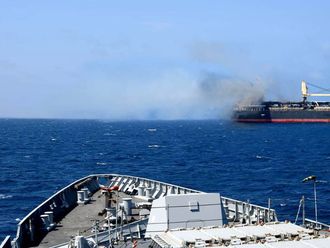Sana’a: The local Al Qaida affiliate saw no need to wait for the Yemen Army to attack before firing off its first tweet about the operation.
As word spread of the impending offensive in south Yemen, Twitter accounts linked to Al Qaida in the Arabian Peninsula switched from condemning US drone strikes to lobbing taunts at the Army, referring to troops as “traitorous dogs” and accusing them of teaming up with Shiite rebels — a smirch in the majority Sunni country.
When the army offensive actually began on April 29, AQAP issued regular updates on the fight while Yemen’s government, stayed mostly silent on social media. Instead Yemeni activists who found their voice during the 2011 uprising took up the task of responding to AQAP and supporting the Army offensive.
The result: AQAP and the Yemeni public have left the government far behind in an information war made possible by the spread of the internet in the Arab world’s poorest nation. Authorities can no longer shape the narrative of counterinsurgency, particularly when it comes to controversial drone strikes.
“Before, the government could almost pretend that the strikes — like many other things — weren’t even happening,” says Farea Al Muslimi, a Yemeni writer who live-tweeted updates from his family after a drone strike occurred in his village last year.
The amplification of nongovernmental voices is a new challenge for the government. Only a few years ago, Internet access in Yemen was limited to the elite.
But the number of internet users in the country increased nearly tenfold between 2010 and 2012, according to government figures, although even with that rapid expansion, less than a quarter of Yemenis have regular internet access.
Most drone strikes, which are believed to be US operations, target the most impoverished and isolated parts of Yemen where AQAP operates. The region’s remoteness plays into the group’s hands; it also makes it easy for the government to suppress any negative information, including civilian casualties from drone strikes and other aerial attacks.
But now Yemenis can easily, quickly share on-the-ground information. Last December, an air strike targeted a wedding convoy, killing roughly a dozen civilians. The government initially identified the casualties as militants, but locals soon began posting photos of the dead on Facebook and tweeting the names of victims, directly challenging the government’s obfuscation.
“Now, [the government] has no choice but to deal with things like civilian casualties. Look at the drone strike...two weeks ago: People knew that three civilians were killed before the Defence Ministry even issued a statement saying that an air strike had occurred. The age of the government being able to control the story is over,” says Al Muslimi.
But he concedes it could be a double-edged sword. “It’s now far easier for others to spread misinformation and propaganda — including AQAP itself.”
Expanding internet access has proven a boon for AQAP’s propaganda operations. Political statements can be disseminated with relative ease and AQAP videos posted on YouTube rack up thousands of views. Widespread distrust of the Yemeni government, as well as a deeply partisan media climate, have given some credence to AQAP’s statements, even among those who view its mission with disgust.
Media-savvy Yemenis say that discerning the truth means balancing a slew of unreliable narrators — of which AQAP is now an accepted part — than of finding one accurate source. Activists, journalists and politicians now treat social networking sites like virtual town squares.
“A decade ago, [the government] could easy shape the story,” said one Yemeni official, speaking on the condition of anonymity. “Now — if they’re smart enough — a group of people with an internet connection can do the same.”












